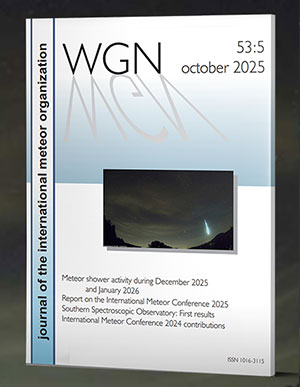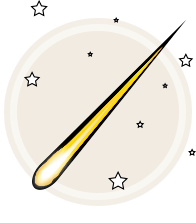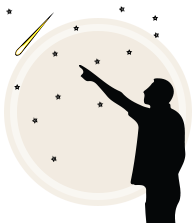September offers longer nights in the northern hemisphere that tend to be less
hazy than those experienced in mid-summer. In the sky, no major showers are
visible from either hemisphere but the northern hemisphere enjoys the advantage
of higher sporadic rates. Most of the shower activity this month is produced
from the Perseus-Aurigid complex active this time of year. These showers rarely
produce more than five meteors per hour but still manage to produce most of the
shower activity seen this month. Unfortunately the Perseus-Aurigid complex lies
too low in the northern sky for southern hemisphere observers to view very well.
Video studies have shown that the Southern Taurids are visible as early as
September 7th therefore after this date the Antihelion radiant will no longer be
listed until the Taurid showers end in December. The Antihelion meteors are
still active but their radiant is superimposed upon that of the more numerous
Taurids, therefore it is impossible to properly separate these meteors. Observers
in the southern hemisphere suffer from some of their lowest rates of the year
this month. The Southern Taurid radiant is not too badly placed so observers
south can expect to see a little of this activity this month.
During this period the moon reaches its full phase on Thursday November 10th. At
this time the moon will lie opposite of the sun and will be present in the sky
all night long. This will be the worse time to try and view meteor activity this
month as the brilliant moonlight will obscure all but the brightest meteors.
This weekend the waxing gibbous moon will set during the early morning hours and
will allow a short glimpse of early November meteor activity under dark
conditions. The estimated total hourly rates for evening observers this week is
near three as seen from the northern hemisphere and two as seen from the
southern hemisphere. For morning observers the estimated total hourly rates
should be near fifteen as seen from mid-northern latitudes and ten from
mid-southern latitudes. The actual rates will also depend on factors such as
personal light and motion perception, local weather conditions, alertness and
experience in watching meteor activity. Evening rates are reduc
ed this week due to moonlight.
The radiant (the area of the sky where meteors appear to shoot from) positions
and rates listed below are exact for Saturday night/Sunday morning November 5/6.
These positions do not change greatly day to day so the listed coordinates may
be used during this entire period. Most star atlases (available at science
stores and planetariums) will provide maps with grid lines of the celestial
coordinates so that you may find out exactly where these positions are located
in the sky. A planisphere or computer planetarium program is also useful in
showing the sky at any time of night on any date of the year. Activity from each
radiant is best seen when it is positioned highest in the sky, either due north
or south along the meridian, depending on your latitude. It must be remembered
that meteor activity is rarely seen at the radiant position. Rather they shoot
outwards from the radiant so it is best to center your field of view so that the
radiant lies at the edge and not the center.
Viewing there will allow you to easily trace the path of each meteor back to
the radiant (if it is a shower member) or in another direction if it is a
sporadic. Meteor activity is not seen from radiants that are located below the
horizon. The positions below are listed in a west to east manner in order of
right ascension (celestial longitude). The positions listed first are located
further west therefore are accessible earlier in the night while those listed
further down the list rise later in the night.
The following showers are expected to be active this week:
Remnants from the famous Andromedid (AND) shower, noted for intense storms
during the 19th century, may still be seen throughout November. The current
position of this large radiant is 01:26 (022) +27. This position lies in a
sparse area of northeastern Pisces. The nearest bright star is third magnitude
Alpha Trianguli, which lies five degrees to the northeast. The radiant is so
diffuse that Andromedid meteors may be seen coming from southern Andromeda,
Triangulum, and northwestern Aries as well as eastern Pisces. Visual activity is
expected to be low, but detectable. An inconspicuous maximum occurs on November
12. The Andromedid meteors are best seen near 2200 (10pm) LST (Local Standard
Time), when the radiant lies on the meridian. At 19km/sec., the average
Andromedid will appear as a very slow moving meteor.
The Northern Taurids (NTA) are active from a large radiant centered at 03:35
(054) +22. This position lies in western Taurus, three degrees southwest of the
famous naked eye cluster known as the Pleiades (seven sisters). The radiant is
best placed near 0100 LST, when it lies highest above the horizon. Since the
radiant is large, Northern Taurid meteors may also appear to come from Aries,
southern Perseus, as well as western Taurus. Meteors from the Northern Taurids
strike the atmosphere at 29km/sec., which would produce meteors of slow
velocity. Expected rates would be near two per hour, no matter your location.
The center of the Southern Taurid (STA) radiant now lies 03:39 (055) +14. This
position also lies in western Taurus, but ten degrees south of the Pleiades.
The radiant is also best placed near the meridian at 0100 LST, but activity may
be seen all night long. Since the radiant is large, Southern Taurid meteors may
also appear to come from Aries as well as Taurus. Striking the atmosphere at 29
km/sec., the average Southern Taurid meteor travels slowly through the skies.
Rates should be near one per hour no matter your location.
The Orionids (ORI) remain weakly active from a radiant located at 07:11 (108)
+16. This position lies in southern Gemini, five degrees east of the second
magnitude star Alhena (Gamma Geminorum). The radiant is best placed near 0400
LST, when it lies highest above the horizon. At 67km/sec., the average Orionid
is swift with the brightest meteors producing persistent trains.
The Leonids (LEO) are just now coming to life from a radiant located at 09:48
(147) +25. This position lies in western Leo only one degree north of the third
magnitude star Algenubi (Epsilon Leonis). Maximum activity is still more than a
week away so current rates would most likely be less than one per hour. At
71km/sec., the average Leonid is swift with a high percentage of trains. These
meteors are best seen during the last hour before the onset of morning twilight,
when the radiant lies highest above the horizon in a dark sky.
As seen from the mid-northern hemisphere (45N) one would expect to see
approximately eleven sporadic meteors per hour during the last hour before dawn
as seen from rural observing sites. Evening rates would be near two per hour. As
seen from the mid-southern hemisphere (45S), morning rates would be near five
per hour as seen from rural observing sites and one per hour during the evening
hours. Locations between these two extremes would see activity between the
listed figures. Evening rates are reduced due to moonlight.
The table below presents a condensed version of the expected activity this week.
Rates and positions are exact for Saturday night/Sunday morning.
| SHOWER | DATE OF MAXIMUM ACTIVITY | CELESTIAL POSITION | ENTRY VELOCITY | CULMINATION | HOURLY RATE | CLASS* |
| RA (RA in Deg.) DEC | Km/Sec | Local Standard Time | North-South | |||
| Andromedids (AND) | Nov 12 | 01:26 (022) +27 | 19 | 2200 | <1 - <1 | III |
| Northern Taurids (NTA) | Nov 13 | 03:35 (054) +22 | 29 | 0100 | 2 – 2 | II |
| Southern Taurids (STA) | Oct 10 | 03:39 (055) +14 | 29 | 0100 | 1 – 1 | II |
| Orionids (ORI) | Oct 22 | 07:11 (108) +16 | 67 | 0400 | 1 – 1 | I |
| Leonids (LEO) | Nov 18 | 09:48 (147) +25 | 71 | 0700 | <1 - <1 | III |



 You saw something bright and fast? Like a huge shooting star? Report it: it may be a fireball.
You saw something bright and fast? Like a huge shooting star? Report it: it may be a fireball.  You counted meteors last night? Share your results with us!
You counted meteors last night? Share your results with us!  You took a photo of a meteor or fireball? You have a screenshot of your cam? Share it with us!
You took a photo of a meteor or fireball? You have a screenshot of your cam? Share it with us!  You caught a meteor or fireball on video? Share your video with us!
You caught a meteor or fireball on video? Share your video with us!